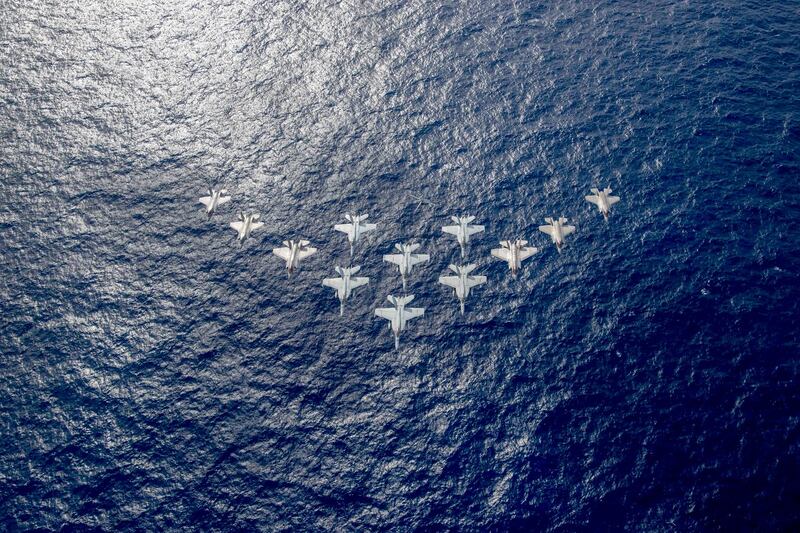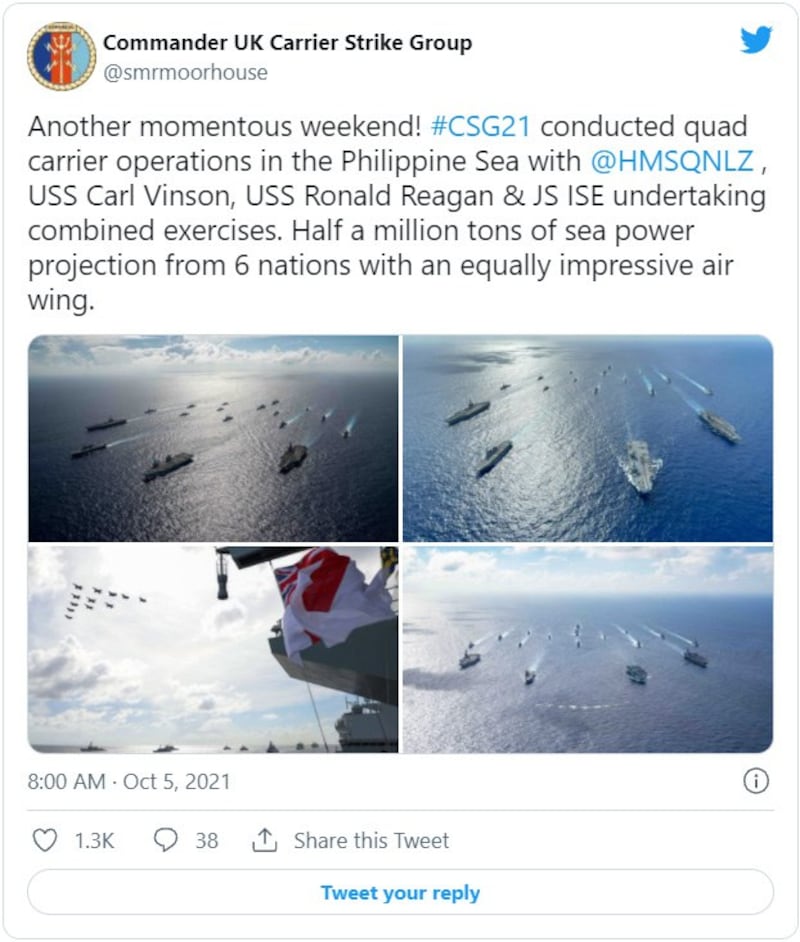Three aircraft carriers and a dozen other warships from U.S.-allied nations sailed on the fringes of the South China Sea this week in one of the biggest shows of Western maritime might in the region for years.
Those drills in the Philippine Sea will be followed by two weeks of large-scale military exercises in the South China Sea – sending a message to Beijing and asserting the freedom of navigation in an increasingly tense Indo-Pacific.
“This is probably the first time since the Taiwan Strait crisis in 1996 that we saw these kind of carrier-based operations,” said Richard Bitzinger, senior fellow at the S. Rajaratnam School of International Studies (RSIS) in Singapore.
On Oct. 3, the British Royal Navy’s flagship aircraft carrier HMS Queen Elizabeth, together with two U.S. carriers – the USS Carl Vinson and USS Ronald Reagan - joined 14 other naval ships from the U.S., U.K., Japan, Canada, New Zealand and the Netherlands to conduct so-called combined exercises in the Philippine Sea.
Images taken at the scene show the impressive armada sailing in the sun, with an arrow-like formation of fighter jets overhead.
“Half a million tons of sea power projection from six nations with an equally impressive air wing,” was how it was described by Commodore Steve Moorhouse, commander of the U.K. Carrier Strike Group 21 (CSG21) led by the HMS Queen Elizabeth.
A day later the SCS Probing Initiative, a Chinese research network, alerted that the USS Carl Vinson and HMS Queen Elizabeth had crossed the Bashi Channel into the South China Sea -- the second time for both of the aircraft carriers since July.
The Carl Vinson has since left for Japan.
A statement from the U.K. Ministry of Defence on Tuesday said that over the next two weeks the Queen Elizabeth “will navigate the South China Sea with ships and aircraft from Australia, Canada, Japan, New Zealand, and the United States” and take part in a large-scale joint maritime exercise.
The RSIS expert Bitzinger was likening the show of force to March 1996, when America deployed two aircraft carriers in response to China testing missiles in seas near Taiwan in the run-up to an election there – sending a warning to self-governing island not to declare independence.
At the time, observers touted it as the biggest display of military power in Asia since the Vietnam War. The U.S. deployed two carrier groups led by the USS Nimitz and the now-decommissioned USS Independence.
The main purpose of the show of force then, same as now, was to send a message to Beijing – and some see that as provocative. “They are assisting the U.S. in threatening China,” said Mark J. Valencia, adjunct senior scholar at China’s National Institute for South China Sea Studies (NISCSS), reflecting Chinese concerns.

But the exercises take place against a backdrop of escalated military activity by China in the Taiwan Strait.
On the same day the U.S. and U.K. aircraft carriers entered the South China Sea, China sent a record 52 military aircraft into Taiwan’s air defense identification zone (ADIZ). Over a four-day period beginning last Friday, Taiwan reported that nearly 150 Chinese air force aircraft flew into its ADIZ.
The Taiwanese Defense Minister, Chiu Kuo-cheng, told lawmakers on Wednesday that the cross-strait tension was "the most serious" in more than 40 years.
The U.S. State Department on Sunday accused the Chinese army of carrying out "provocative military activities" that “undermines regional peace and stability," adding "the U.S. commitment to Taiwan is rock solid.”
China considers Taiwan a break-away province and vows to unite it with the mainland, by force if necessary. Taiwan, however, regards itself as a de facto sovereign state and points to the fact that is has never been part of the 72-year-old People's Republic of China.
“A lot of countries attached around Asia worry about Chinese aggressiveness and this is a way of sending a powerful message [to China] about freedom of navigation and operations,” Bitzinger said of the aircraft carrier joint exercises.
“It is also to show that the U.S. have allies and friends who participate actively and closely with the U.S.,” he said.

Homegrown aircraft carriers
The presence of aircraft carriers is generally perceived as a potent symbol of freedom of navigation promoted by the U.S. and its allies. It also reveals an interesting trend in the way some countries in the Indo-Pacific develop their maritime defense capabilities with homegrown aircraft carriers.
The Japan Maritime Self-Defense Force (JMSDF or Japanese Navy) announced on Tuesday that they conducted take-offs and landings of the U.S-made F-35B advanced fighter jets to the helicopter destroyer JS Izumo, effectively making it into an aircraft carrier.
“The JMSDF continues to steadily carry out the necessary modifications to the Izumo class to acquire the capability to operate the F-35Bs,” it said.
The Japanese government in 2018 gave the green light to convert two existing Izumo-class destroyers into light aircraft carriers that can operate F-35B fighters. This was based on a major policy shift since 2015 when Japan -- whose military activity is constrained by its post-World War II pacifist constitution -- expanded its commitments to the U.S. security alliance, according to Jeff Kingston, Director of Asian Studies and a professor at Temple University in Tokyo.
“Japan has greatly increased its ability to project its maritime power and shrugged off longstanding taboos on security policy in doing so. Geopolitically it is a response to a heightened perception of risk due to China’s military modernization program and regional hegemonic ambitions,” Kingston told RFA.
“Japan participates in the Quad (grouping between the U.S., India, Japan and Australia) and has been an advocate of a free and open Indo-Pacific, a concept aimed at containing the expansion of China's regional influence that involves, among other things, joint naval exercises,” explained the professor, adding: “Now Japan can include aircraft carriers.”
Valencia from the Chinese NISCSS however warned that the making of aircraft carriers and support for the U.S. to constrain China could be a mistake for Japan.
“Of course, Japan should have the capability to defend itself but fielding aircraft carriers is another matter entirely,” he said.
According to RSIS’s Bitzinger, Korea and Singapore are both also looking at developing some of their amphibious naval vessels into de-facto aircraft carriers.
“Twenty years ago, everybody was negative about them (aircraft carriers), what they called cruise missile magnets because they’re too big. But now everybody is trying to get them!”
“It’s as if they’re trying to counter the fact that China’s increasingly got carriers. It’s sort of saying that ‘we’re going to match you guys. In fact, we can overmatch you!’” said Bitzinger.
China, aiming at becoming a maritime superpower, has two aircraft carriers in active service – the Liaoning and Shandong, and is building a third. China already has the largest navy in the world but mainly of smaller classes of ships. Supercarriers would greatly boost its power projection.
The race to develop bigger and better carriers highlights the precarious situation in the South China Sea, which is seen by observers as one of potential conflict zones between superpowers.
It will also force smaller, poorer countries in the region “to pick a side, to a large extent,” said Bitzinger.
“All the smaller ASEAN (Southeast Asian) countries would love for China and the U.S. to get along but that’s not going to happen and trying to remain outside of it all becomes harder and harder,” he added.
